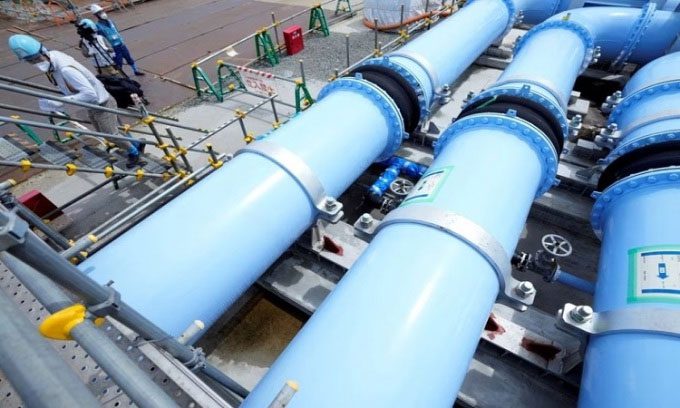The Fukushima Daiichi Nuclear Power Plant dilutes radioactive wastewater treated with seawater before discharging it into the Pacific Ocean.

The blue pipeline brings seawater to dilute the treated radioactive water. (Photo: Reuters)
In a small corner of the main control room at the Fukushima Daiichi Nuclear Power Plant in northeastern Japan, a technician flips the switch to transport the treated water. A graph on a nearby computer screen shows the water level steadily decreasing as the treated radioactive wastewater is diluted and discharged into the Pacific Ocean. Near the plant’s coastline, two seawater pumps are operating, pouring seawater through a blue pipeline into a large tank. There, radioactive water flows through a thicker black pipeline from an overhead storage tank, diluted a hundredfold before being discharged, according to AP.
The sound of diluted radioactive water flowing into an underground secondary tank can be heard from below ground. According to Tokyo Electric Power Company (TEPCO) spokesperson Kenichi Takahara, the best way to eliminate contaminated water is to manage the stockpile of melted fuel. However, information about the situation inside the reactors is scarce, making the planning and development of necessary robotic technology and facilities for managing the melted fuel extremely challenging.
A technician monitors the level of radioactive water being discharged into the ocean. (Video: Reuters)
The discharge of radioactive water has been planned for decades but has faced strong opposition from fishing organizations and criticism from neighboring countries. China immediately banned seafood imports from Japan in response. In Seoul, thousands of South Koreans protested over the weekend to condemn the discharge activities.
For the Fukushima Daiichi plant, managing the increasing amount of radioactive water stored in over 1,000 tanks poses safety risks and remains a significant burden following the meltdown disaster in March 2011. The discharge operation marks a milestone in the decommissioning process of the plant, which is expected to last for decades. However, it is just the beginning of a series of challenges ahead, such as dealing with the radioactive melted fuel remaining in the three destroyed reactors.
The plant is managed by Tokyo Electric Power Company (TEPCO), which has begun discharging 7,800 tons of radioactive water from 10 tanks in the B group, containing the least radioactive treated wastewater at the plant. According to them, the water has been treated and diluted to levels safer than international standards. Test results from TEPCO and government agencies indicate that the radioactivity in seawater and fish samples taken after discharge is below detectable levels. The Japanese government and TEPCO emphasize that discharging the water is an unavoidable step in the process of decommissioning the plant.
The earthquake and tsunami in March 2011 destroyed the plant’s cooling systems, causing three reactors to melt down. Polluted cooling water used for the damaged reactors has continuously leaked into the basement of the facility and mixed with groundwater. This water is collected and partially recycled as treated cooling water, while the remainder is stored in 1,000 tanks, which are now 98% full, with a total capacity of 1.37 million tons.
The discharge operation begins at a rate of 460 tons of water per day, progressing very slowly. TEPCO states that it plans to discharge 31,200 tons of treated water by the end of March 2024. This plan will only empty 10 of the 1,000 tanks, as radioactive water is continuously generated. The rate will then increase, and about one-third of the tanks will be emptied within the next ten years, freeing up space for decommissioning the plant. According to TEPCO executive Junichi Matsumoto, who oversees the discharge, radioactive water will be discharged regularly over a period of 30 years. However, as long as melted fuel remains in the reactors, the plant will still need to use cooling water.
Approximately 880 tons of melted nuclear fuel remain inside the reactors. Automated probe ships provide some information, but authorities have little understanding of the condition of the melted fuel, and the volume may be larger, according to Takahara. Testing for the removal of melted fuel using remotely controlled robotic arms will begin in Unit 2 at the end of this year after nearly two years of delays, although the volume to be processed is very small. The removal of spent fuel from the cooling pool of Unit 1 is set to begin in 2027 after a 10-year delay. The upper part of the reactor remains covered by debris from the explosion 12 years ago and needs to be cleared before constructing a containment dome to prevent radioactive dust.
Inside Unit 1, which suffered the most damage, most of the reactor core melted and fell to the bottom of the primary containment chamber. Probes sent into the containment chamber of Unit 1 have discovered that the support structure just beneath the core has been severely damaged. Most of the thick outer concrete layer is missing, exposing the rebar inside, prompting regulators to request TEPCO to conduct a risk assessment.
The Japanese government aims to complete the decommissioning of the plant within 30 to 40 years. This overly ambitious plan could expose plant workers to radiation and cause further environmental damage. Some experts believe it may not be possible to remove all melted fuel by 2051, suggesting instead that the process could take 50 to 100 years.



















































